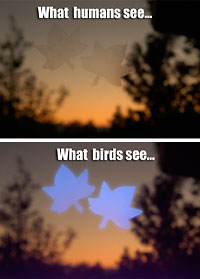Top Seven Tactics to Keep Birds From Crashing Into Windows
OK, there are tons of perks when it comes to working for PETA. I’m talking cool coworkers, a kick-ass cause, a vegan vending machine, and a multi-office building with lots and lots of windows overlooking the Elizabeth River. But as is often the case, every perk comes with a price. And I’m not just talking about the small fortune I’ve invested in Twizzlers (I wish I could quit you, vending machine!). I’m talking about having HUGE windows. Honestly, we love birds, but we really, really don’t want them to literally crash our meetings.
You see, we PETA folks like our views, but unlike a lot of other offices, we also care about how our feathered friends view us. Luckily, some of those cool coworkers I was bragging about earlier have come up with some pretty tight tactics to keep birds from colliding with windows, and we urge you to implement them not only at home (if there’s a problem there) but also at work (if there’s a problem there):
1. Play detective. Are there certain windows in your home or office that attract more collisions than others? A little detective work goes a long way in helping you determine which windows to focus on.
2. Stop being so transparent. Find ways to avoid or minimize the reflectivity and transparency of glass windows and doors. Building a home or replacing windows? Use skylights, lattice windows, and materials that are nontransparent and minimally reflective.
3. Decorate with decals. We highly recommend clear decals that reflect ultraviolet light, which is visible to birds and allows them to steer clear and stay safe. If you’re more of a DIYer, bust out some “MacGyver” ingenuity and use tape, adhesive film, or other items on your windows to make them more visible.
4. Explore all your options! Look for ways to cover the maximum amount of surface area outside your window. We went with window tinting after putting interns on our balconies with glow sticks didn’t pan out (they left work and went dancing instead).
5. Avoid a “dine and crash” situation. Place birdfeeders and nest boxes at least 30 feet away from windows or within 2 to 3 feet of them.
6. Help our feathered friends. If you find a bird who is dazed and confused (face it, we’ve all been there), put some gloves on and place the bird somewhere safe and quiet to recover for an hour or two. According to our wildlife expert extraordinaire Tori, they can normally be cleared for takeoff after a brief rest and quick eval.
7. Be prepared if the birdie doesn’t bounce back. If your patient requires more medical attention, call animal control (have the number handy BEFORE something happens, and know what action to take for after-hours emergencies). If animal control can’t help, they should be able to refer you to a wildlife center, rehabber, or veterinarian who can. And remember, it’s illegal in most states to try to rehab a wild animal yourself, so you MUST take him or her to one of these places.
Posted by Amy Elizabeth

